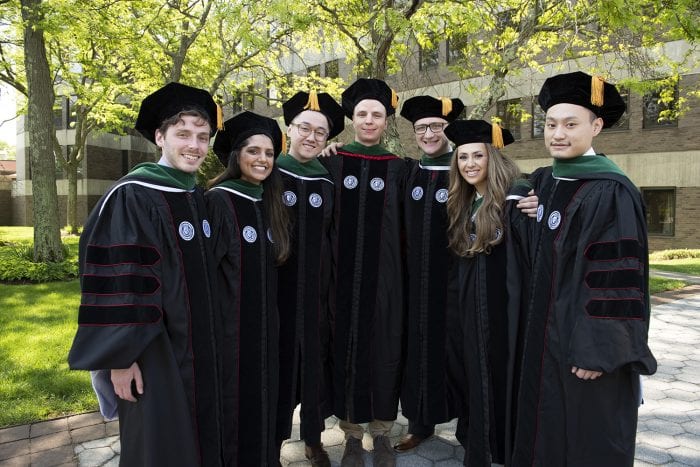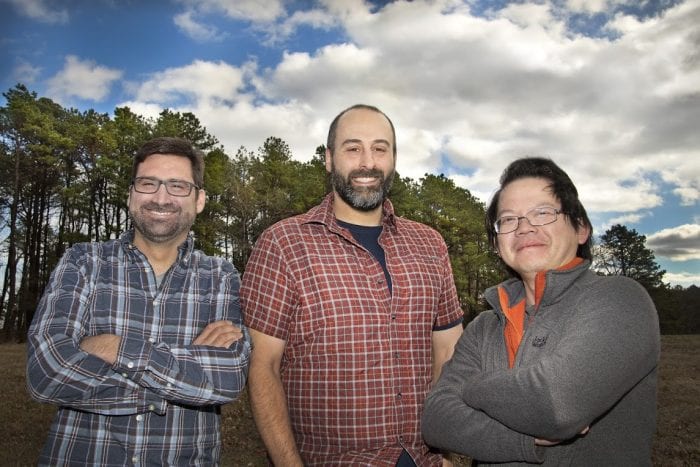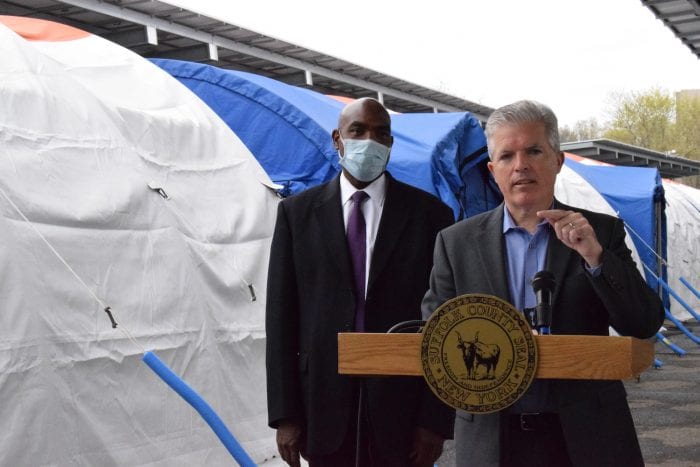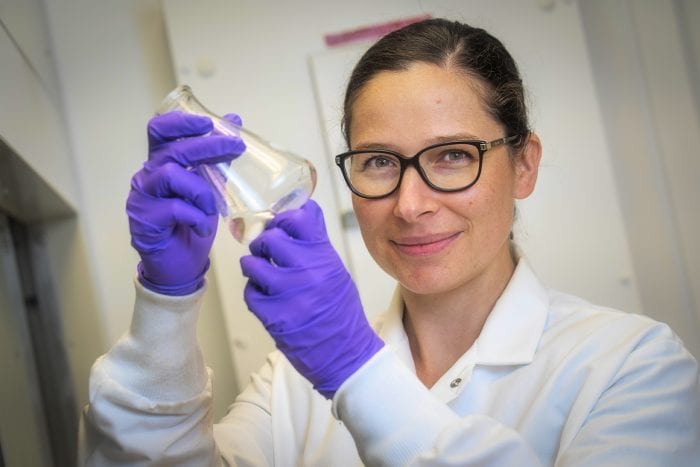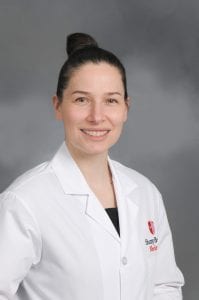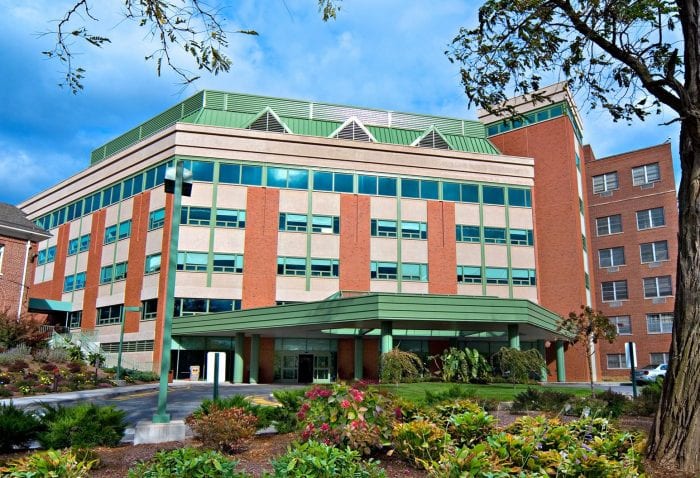Behind every stethoscope is a story.

This year, the stories among the new doctors who recently graduated from the Renaissance School of Medicine at Stony Brook University developed against the backdrop of a pandemic and included numerous firsts for the school and for the families of graduates.
Seven of the 150 graduates, which is the largest medical school class to earn a medical degree from Stony Brook, completed their training in three years, joining a small but growing trend among medical schools that are encouraging more people to consider becoming physicians while reducing the potential debt that can accrue while earning their medical degree.
“This year is really going to stand out,” said Andrew Wackett, vice dean of Undergraduate Medical Education and the director of the Clinical Simulation Center. “This was a group of students that really went through an awful lot. They rose to the occasion. They didn’t complain. Rather than do that, they tried to figure out how to help. It’s a special group of physicians that will make a great impact.”
Indeed, amid the worst of the pandemic, which hit Suffolk County especially hard during the spring of 2020, medical school students performed a host of important tasks, just as so many other health care professionals took on additional responsibilities and put themselves in harm’s way to protect the public.
Students volunteered to help with research, assisted patients who needed to connect with clinicians through in-person or telehealth and did “a lot of work with following up to make sure [residents] were doing okay when they were discharged,” Wackett said. These students were “really important in organizing the vaccine strategy,” as a number of them trained and volunteered to give vaccines. “They doled out thousands of them.”
Wackett suggested that the adversity caused by the pandemic has enabled class members to become resilient.
“What they learned, more than anything, was that they could adapt to whatever the world threw at them,” Wackett said. “It made them a much tougher group of students.”
Wackett said he was moved by the story of Chineze Nwebube, who described in the Graduate Address how she took the MCAT several times and had moments when she thought about giving up.
With the support of her family, she persisted and was “an exceptional medical student and will be an incredible physician,” Wackett wrote in an email.
Wackett said the spotlight on social injustice amid the pandemic also affected the dialog and the didactic efforts at the medical school.
“Certain populations have disparate health care, and we need to be involved to make that better,” Wackett said. That includes an analysis not just of disease or pathology, but also a consideration of how social factors impact the course of illnesses.
“Courses that traditionally taught science [are also] looking at the social context,” he said. “Medicine and public health are way more interconnected than we even realized.”
The graduates are preparing to venture into a world in which new lessons learned in the classroom and the clinic will prove especially valuable. At the same time, they bring a passion, dedication and conviction to the communities they plan to serve.
In between graduating and taking the next steps in their medical careers, some of this year’s graduates shared their inspiring and inspired stories.

Here comes the married couple
Monica Lenis didn’t think Jheison Giraldo, the guy from another class who was making up a lab in undergraduate biology at Stony Brook University, was all that funny. That just made him try so much harder, prompting eye rolls from a tough audience.
“His jokes were not making me laugh,” Monica recalled about that fateful science class eight years ago. “Somehow, we hit it off. We started talking after that and got to know each other.”
Despite Monica’s initial resistance to his charms, the couple started spending considerable time together, where they realized how much they had in common.
For starters, they were born in Colombia, five hours apart by car. Their families had moved to Long Island, his to Brentwood and hers to Bethpage, when each of them was nine years old.
Once they started to get to know each other, they appreciated each other’s strengths.
Jheison, who describes himself as the more outgoing of the two, tried to compete with Monica academically. That didn’t work out too well.
On a test in Biochemistry 2, in which the average was around 40, he reached the high 90s. He confidently went over to Monica, figuring he had to have beaten her.
She scored a 102, getting all the questions right and adding the two extra points.
“If you can’t beat them, join them,” he said. “I knew being next to her, she’s going to push me to excel in every way I could. I would do the same for her.”
Monica appreciated Jheison’s pervasive and persistent positive attitude. She also appreciated how well he interacted with her parents and her family, enjoying the older brother role he took with Monica’s 15-year-old brother.
After they graduated from Stony Brook, they got married. Jheison had always known he wanted to be a physician, dressing up for Halloween close to a dozen times as a doctor. Monica had other interests, including in the law. In addition to falling in love with Jheison, she also developed a deep appreciation for science in college and eventually deciding that she didn’t want to conduct research.
They applied to 30 medical schools. When they decided to go to Stony Brook together, they became the first married couple to enter the medical school together.
“When we first started” meeting people in the class, some of their peers “thought of us as the grown-up couple,” Monica said. Each of them, however, established their own academic and social friend groups.
While in medical school, they supported each other, as they focused on becoming, as Jheison put it, “the best physicians we could.”
Now that he is planning to become a resident in internal medicine and pediatrics and she plans to focus on internal medicine and cardiology, the medical couple has decided to contribute to a community they feel could use their support.
“From day one, we wanted to go to a place where we could be faced with patients who need more equity and diverse doctors working with them,” Jheison said. “We always looked at strong minority areas or historically under-represented areas. Miami stood out for us.”
While Long Island has been her home since she arrived in the United States in 2002 and has a “special place in my heart,” Monica is excited for an opportunity for personal growth. She is also thrilled to get away from the snow and the cold.
As she prepares for the next chapter in her life, she is looking forward to continuing in her journey with Jheison, who is “very positive and very uplifting. He’s always been very supportive, which is really all you could ask for in a partner.”

Dr. Mom
Like many of her friends in the Orthodox Jewish community, Eliana Fine got married soon after high school, at the age of 19. Within two years, she gave birth to her son Ezra and, six months ago, to her daughter Sophia.
She could have dedicated herself and her time to becoming a stay-at-home mom, enveloping herself in a culture that emphasizes family and community and that keeps many women incredibly busy taking care of their often numerous children.
Instead, with the valuable and necessary support of her husband Mark Feld, Eliana decided to go a different route, not only pursuing a career as a doctor but also earning her degree in three years.
“I come from a community where most of the women don’t work,” Fine said. “I honestly didn’t even know any other orthodox Jewish woman who was a physician or was a medical student or physician trainee.”
Fine, however, wanted to develop her own career, particularly in the field of obstetrics and gynecology, where she felt she could help women, particularly in her community.
She described how the women in her community often don’t have extensive knowledge about reproductive and sexual health education before they get married. Women often have a kallah teacher, who is usually the wife of a rabbi.
“Your education is really based on the knowledge of your teacher,” Fine said, and “what they feel comfortable teaching you.”
Fine wanted to give back to her community, educating women about medical and health issues that can help “empower them to make better health care decisions.”
As a physician, Fine hopes to help other orthodox Jewish women understand more about women’s health and fertility.
“If women are having difficulty conceiving, the peer pressure can be stressful,” she said. “All of your friends are having kids and you’re not moving forward with your family.”
She wanted to give back to a community that she loves and that provides the context and framework for her life.
“There’s a lot of misconceptions when it comes to contraception,” Fine said. “People think contraception causes infertility. People don’t necessarily utilize contraception because of various misconceptions about it.”
To get to this point in her career, Fine said she had to overcome some of the expectations of a culture that sometimes places a stronger emphasis on family, particularly for women, than it does on developing careers.
She appreciated and is grateful for the support of her husband and her grandfather, Dr. Richard Fine, who was a dean of Stony Brook Medical School. When she was younger, she knew he was a physician, but wasn’t aware of his extensive career beyond that. She appreciated his regular questions to her about what she wanted to do when grew up, which allowed her to think for herself about what motivates her and how to make a difference in the world.
Fine believes that her experience and background as a member of the Orthodox Jewish community will help her relate to and communicate with her patients.
“Women have these family purity laws and it’s really important to go to an OB/Gyn who is very familiar with these laws. To be a part of the culture and come from the same community, you understand how to provide care.”
Fine, like several of her colleagues in the inaugural three-year medical program, felt closer to the incoming class of 2018 than to the graduating class of 2021, with whom she interacted primarily in the last six months of her medical school training.
During graduation, Fine appreciated the opportunities she feels she had that others don’t always get.
“I want to make sure I do something great with the opportunity I was given and make a difference in the world,” Fine said.
As for her children, Fine would like them to see that they, too, can choose how they live their lives, regardless of any expectations that others place on them.
“I would like to show my kids, if I can do it, they can do it,” she said. “I want them to know they have choices in life and that I will support whatever they choose. They should know they have the wings to fly, in terms of having a career and going to college.”

Early challenges
When Adam Bindelglass was five years old, the car he was in slid across black ice into oncoming traffic, which took the life of his two-year-old sister Amy.
Bindelglass also sustained serious injuries, breaking both his arms, his left leg, collar bone, and fracturing his neck. During his recovery, he had to wear a halo on his head to keep his spine aligned until it healed. The halo and the injuries left numerous scars, which triggered questions from his classmates.
“I have a pretty long scar from the base of my skull down my neck,” Bindelglass said. “I was self-conscious about those scars.”
Additionally, he has scars on his right bicep, and he has a mark that used to stretch the entire length of the long bone on his leg.
Motivated by the desire to help other people, particularly in difficult medical situations, Bindelglass said that day, and the scars he now bears as a mark of his career commitment, brought him to this landmark career moment.
A recent medical school graduate, Bindelglass said his experiences early in life have come up several times when he interacts with patients in high-stress situations in the hospital.
He recalled one incident when he spoke with a patient who was about to undergo spinal surgery.
He described how he could “live a full, fulfilling life without complications from these operations,” Bindelglass said. “I hope to continue to bring that [empathy], especially since the patients I’ll be working with [could be] in an acute situation where I’m going to see them right before one of the potentially the biggest operations or procedures of their life.”
He hopes to bring comfort and peace of mind going into surgery.
A three-year graduate from medical school, Bindelglass plans to continue in a residency at Stony Brook in anesthesia. Bindelglass said the pandemic showed him the importance of managing patients’ airways.
Bindelglass said he thinks about his sister “all the time” and hopes she “would be proud” of his commitment to helping others with his career choice.

The magic of threes
Simrat Dhaliwal graduated from Northeastern with her bachelor’s degree in neuroscience in three years and repeated the pattern at Stony Brook’s Renaissance School of Medicine, where she recently earned her medical degree.
The pattern of moving through degree programs in one fewer year is a by-product of several factors.
Dhaliwal is “efficient with time,” she said. “Medicine is a very long route. I know the path I want to take.”
Dhaliwal, whose mother Tejwinder Dhaliwal is a nurse practitioner at Rochester Regional and served as a health care role model, wanted to be a doctor from the time she was in kindergarten. As she attended middle school and high school, she became fascinated with science. She majored in neuroscience at Boston University.
Comparing the accelerated pace of her undergraduate years to medical school, Dhaliwal said the medical education is considerably more rigorous.
“As an undergraduate, once you finish a course, you can forget [some of the material] and move on,” she said. In medical school, students build “on the foundation. If you never had that strong foundation, there’s no way to move on. You’ll be responsible for patients” someday and “you need to know as much as possible.”
Indeed, the pandemic reinforced Dhaliwal’s decision to become a doctor, showing her that doctors had to “fall back on that foundation to help patients in need,” she said. “This pandemic made me want to become a physician even more because it is [a combination of] public service and critical thinking at the same time. There is no greater service to the public than helping someone, especially when it is in such high demand.”
Dhaliwal, who is starting her residency in internal medicine at Stony Brook on July 1, said her parents are originally from a rural part of India.
In her travels to visit family in India, she has “seen the health care disparity that exists in a non-developed nation.” For people in rural India, the nearest hospital is a 45-minute drive, which can create a dangerous delay for people who are having a heart problem or a stroke, where minutes can make the difference in a prognosis.
One of the most important lessons she learned from medical school is to keep learning. The same holds true for her expectations of herself when she practices medicine. She hopes to help educate people about how “preventive medicine is as important as treatment.”

